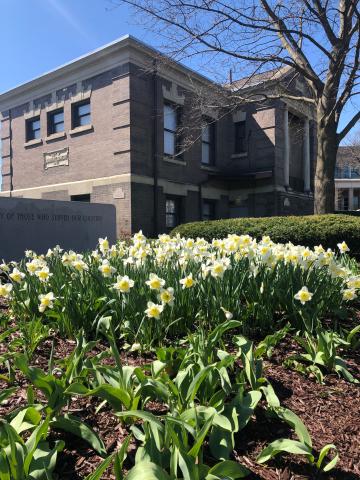
1875 - 1900
Kent’s public library had its beginning on September 29, 1875, when a number of men employed by the Atlantic and Great Western Railroad met on the second floor of the railroad station and organized the Atlantic and Great Western Railroad Reading Room Association. J. H. Devereau, president of the railroad, started the movement. The library's president was P.D. Cooper, vice-president A. L. Dunbar, and George E. Hinds was appointed secretary and treasurer. Hinds selected and purchased books for the collection in Cleveland. Applications for membership in the association had to be approved by the directors and were exclusive to railroad men. The annual dues were $1 and a member was allowed to draw one book at a time, to be kept not longer than three weeks.
The reading room association flourished for some time but interest in it finally waned. From 1884 until 1892 the books were locked in a room at the station. At that time there was no law which enabled a town with less than 5,000 inhabitants to tax itself for library purposes. In 1892 the population of Kent was about 3,300. However, through the efforts of Scott Williams and George E. Hinds such a law was finally passed by the Ohio State Legislature, and Kent became the first town which obtained a library as a result.
The village council passed an ordinance to establish a public library to be known as Kent Free Library and Reading Room and to maintain the library, a tax of one mill was approved. There would be no annual dues, hence the name Kent FREE Library. In 1892 the Kent Free Library and Reading Room was located on the second floor of the Worthington Block. Shelves were put in, and tables and chairs were purchased. Eight-hundred books of the railway library were given as the opening collection for the town library. Mrs. J. M. Woodard was employed as a librarian at a salary of $12.50 a month. The library was soon ready for the public and at once became popular with book lovers and children of the town. In 1895, Mrs. Woodard resigned and Mrs. J. S. Cook was appointed to succeed her. In 1896, the library moved to the second floor of the then new Williams block where it remained until 1903.
Carnegie Library
In 1901, through the efforts of George E. Hinds and members of the library board, Andrew Carnegie agreed to give $10,000 to construct and furnish a library building on the condition that the town provide a site and agree to contribute 10% of the gift yearly for the library’s maintenance. Marvin Kent donated the lot at the corner of Main and River Streets and the town voted by an overwhelming majority to approve the necessary tax levy. Mr. Kent made one stipulation, that space on the northeast corner of the lot was to be reserved for a soldiers' monument. Plans for the library were drawn by Charles Hopkinson of Cleveland, and in June, 1902, the contract for the building was awarded to A. C. Stambaugh.
The building was completed in the spring of 1903. At the request of the Board, Carnegie gave an additional $1,500 for the furnishings of the library. Nellie Dingley of Painesville was employed as librarian and Janet M. Green, library organizer for the state of Illinois, was engaged to organize and catalog the new library's collection in a systematic manner.
On September 25, 1903, the doors of the library were opened to the public. From then on, it rapidly grew and prospered. In 1904, the plans and model of the building were sent to the Louisiana Purchase Exposition in St. Louis, as a perfect model of a $10,000 library building. In 1923, the Coterie planted on the library lawn in the northeast corner a Norway maple tree in memory of Nellie Dingley. In 1928, the rooms in the basement which had been used as family rooms for the janitor were remodeled into one large room. With a fireplace, shelving, many windows and window seats, linoleum on the floor and new comfortable chairs, this made a pleasant assembly room for the various clubs of the town.
Modern Library
Several additions were made throughout the years, however, in 2005, all previous additions were demolished and a new, three-story addition was constructed which tripled the previous amount of available space. This new addition opened on September 26, 2006, exactly 103 years after the original Carnegie building opened. The original 1903 library building still stands today; The Carnegie Section, as it is designated, currently houses The Burbick Foundation Genealogy Room, with the library’s collection of genealogy and local history materials; The Keller Room; and The Bumphrey Room. In recent years, generous support from community members has provided for the Wiland Room, a small conference room; the Woodward Room, a quiet reading area; the James Benedik teen area; the Gillis bequest to provide homebound services; and the Solem bequest which supports the library’s purchase of audio books.
| Head Librarian/Library Director Name | Years of Service |
| J.M. Woodard | 1892 - 1895 |
| J.S. Cook | 1895 - 1903 |
| Nellie Dingley | 1903 - 1910 |
| Bessie Kent | 1910 - 1913 |
| Jennie A. Shuman | 1913 - 1944 |
| Marjorie Cochran | 1944 - 1952 |
| Margaret Zearley | 1952 - 1972 |
| Clare Gearheart | 1972 - 1974 |
| Carmen Zampini (Celigoj) | 1974 - 2011 |
| Stacey Richardson | 2011 - Present |
History provided in part by: Grismer, Karl H. The History of Kent: Historical and Biographical. Kent Historical Society: Kent, OH. 1932 (rev 1992). 129 – 131.
